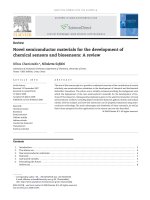Materials for the Hydrogen Economy Edited by Russell H doc
Bạn đang xem bản rút gọn của tài liệu. Xem và tải ngay bản đầy đủ của tài liệu tại đây (9.37 MB, 354 trang )
Materials for the
Hydrogen Economy
5024.indb 1 11/18/07 5:44:07 PM
5024.indb 2 11/18/07 5:44:07 PM
Materials for the
Hydrogen Economy
Edited by
Russell H. Jones
George J. Thomas
CRC Press is an imprint of the
Taylor & Francis Group, an informa business
Boca Raton London New York
5024.indb 3 11/18/07 5:44:07 PM
CRC Press
Taylor & Francis Group
6000 Broken Sound Parkway NW, Suite 300
Boca Raton, FL 33487‑2742
© 2008 by Taylor & Francis Group, LLC
CRC Press is an imprint of Taylor & Francis Group, an Informa business
No claim to original U.S. Government works
Printed in the United States of America on acid‑free paper
10 9 8 7 6 5 4 3 2 1
International Standard Book Number‑13: 978‑0‑8493‑5024‑5 (Hardcover)
This book contains information obtained from authentic and highly regarded sources. Reprinted
material is quoted with permission, and sources are indicated. A wide variety of references are
listed. Reasonable efforts have been made to publish reliable data and information, but the author
and the publisher cannot assume responsibility for the validity of all materials or for the conse‑
quences of their use.
No part of this book may be reprinted, reproduced, transmitted, or utilized in any form by any
electronic, mechanical, or other means, now known or hereafter invented, including photocopying,
microfilming, and recording, or in any information storage or retrieval system, without written
permission from the publishers.
For permission to photocopy or use material electronically from this work, please access www.
copyright.com ( or contact the Copyright Clearance Center, Inc. (CCC)
222 Rosewood Drive, Danvers, MA 01923, 978‑750‑8400. CCC is a not‑for‑profit organization that
provides licenses and registration for a variety of users. For organizations that have been granted a
photocopy license by the CCC, a separate system of payment has been arranged.
Trademark Notice: Product or corporate names may be trademarks or registered trademarks, and
are used only for identification and explanation without intent to infringe.
Library of Congress Cataloging‑in‑Publication Data
Materials for the hydrogen economy / editors, Russell H. Jones, George J.
Thomas.
p. cm.
Includes bibliographical references and index.
ISBN‑13: 978‑0‑8493‑5024‑5 (alk. paper)
1. Hydrogen‑‑Industrial applications. 2. Materials‑‑Research. 3. Hydrogen as
fuel‑‑Research. 4. Hydrogen industry. I. Jones, Russell H. II. Thomas, George J.
TP245.H9M387 2007
665.8’1‑‑dc22 2007020789
Visit the Taylor & Francis Web site at
and the CRC Press Web site at
T&F_LOC_A_Master.indd 1 6/28/07 4:05:10 PM5024.indb 4 11/18/07 5:44:08 PM
I thank my wife, Cathy, for her support during the time needed
to assemble this book, the contributors who helped make it a
reality, and the publisher for their patience with this project.
— Russell H. Jones
5024.indb 5 11/18/07 5:44:09 PM
5024.indb 6 11/18/07 5:44:09 PM
vii
Contents
Preface ix
Introduction xi
Contributors xix
Abstract xxi
Editor xxiii
Chapter 1 Issues in Hydrogen Production Using Gasication 1
James P. Bennett
Chapter 2 Materials for Water Electrolysis Cells 37
Paul A. Lessing
Chapter 3 High-Temperature Electrolysis 61
S. Elangovan and J. Hartvigsen
Chapter 4 Materials Development for Sulfur–Iodine Thermochemical
Hydrogen Production 81
Bunsen Wong and Paul Trester
Chapter 5 Materials Requirements for Photobiological Hydrogen
Production 123
Daniel M. Blake, Wade A. Amos, Maria L. Ghirardi, and
Michael Seibert
Chapter 6 Dense Membranes for Hydrogen Separation and Purication 147
U. (Balu) Balachandran, T. H. Lee, and S. E. Dorris
Chapter 7 Effects of Hydrogen Gas on Steel Vessels and Pipelines 157
Brian P. Somerday and Chris San Marchi
Chapter 8 Hydrogen Permeation Barrier Coatings 181
C. H. Henager, Jr.
5024.indb 7 11/18/07 5:44:10 PM
viii Materials for the Hydrogen Economy
Chapter 9 Reversible Hydrides for On-Board Hydrogen Storage 191
G. J. Thomas
Chapter 10 The Electrolytes for Solid-Oxide Fuel Cells 209
Xiao-Dong Zhou and Prabhakar Singh
Chapter 11 Corrosion and Protection of Metallic Interconnects in Solid-
Oxide Fuel Cells 229
Zhenguo Yang, Jeffry W. Stevenson, and Prabhakar Singh
Chapter 12 Materials for Proton Exchange Membrane Fuel Cells 251
Bin Du, Qunhui Guo, Zhigang Qi, Leng Mao, Richard Pollard,
and John F. Elter
Chapter 13 Materials Issues for Use of Hydrogen in Internal Combustion
Engines 311
Russell H. Jones
Index 319
5024.indb 8 11/18/07 5:44:10 PM
ix
Preface
The purpose of this book is to provide the reader with a comprehensive overview of
materials being developed or considered for a hydrogen-based energy economy, the
state of their development, and issues associated with their successful deployment.
It is our hope that this book will be useful to both the newcomer to this eld and the
experienced engineer and researcher desiring to know more about the broader topic.
It is expected that students, professors, engineers, scientists, and managers will nd
this book useful.
5024.indb 9 11/18/07 5:44:10 PM
5024.indb 10 11/18/07 5:44:11 PM
xi
Introduction
Will a hydrogen-based energy economy, with its promise of clean, sustainable
energy, become a reality? This is clearly a complex issue involving economic and
societal drivers (such as energy independence, energy costs, global warming, pollu-
tion), politico-economic decisions (such as infrastructure investment, R&D invest-
ment), and exogenous developments (such as advancements in the performance of
other energy systems, military conicts).
These economic and societal issues will play out on the national and global
stage; however, the use of hydrogen as an energy carrier may ultimately hinge upon
the performance achieved in hydrogen production, distribution, storage, and propul-
sion systems and components. The performance of these, in turn, is highly depen-
dent on technological advancements, particularly on the properties of the materials
used in their manufacture. In other words, materials are a key enabling technology
to a viable hydrogen economy.
Even a cursory examination of the material properties needed in various hydro-
gen components suggests that a multidisciplinary approach will be needed to over-
come some of their current limitations. However, before examining materials issues
in detail, a brief look at just two of the factors that may lead society to consider
alternative energy supply systems, such as hydrogen, will help us better understand
the scope and impact of the problem.
Oil Supply
Technologically advanced countries are prodigious consumers of oil. World oil con-
sumption (ca. 2004) is about 80 million barrels a day and close to the world’s produc-
tion capacity for this resource.
1
The U.S. alone consumes nearly 20 million barrels a
day, much of which supports the transportation sector of the economy.
1
Globally, the
use of oil and its derivatives continues to increase with no slowing in sight. Since the
standard of living correlates closely with energy consumption in the modern world,
the emerging economies of China and India, coupled with the reticence on the part
of large oil-consuming nations (particularly the U.S.) to reduce energy consumption,
can only point to an ever-increasing demand for oil.
What the future holds for oil supply and demand has been the subject of a number
of recent books,
2–6
with conicting viewpoints expressed on such issues as the time-
scale for reaching the Hubbard Peak
2
in oil production, current oil reserve estimates,
the ability of economic forces to drive exploration and expansion of oil reserves, and
the role of more difcult to obtain and expensive sources of oil (such as tar sands)
to satisfy demand. A related issue to natural oil supply is the dependence of many
nations, including the U.S., on imported oil for the bulk of their energy requirements
and the impact this has on their national security. Historically, in terms of national
policies, energy security has typically translated into short-term military security,
5024.indb 11 11/18/07 5:44:11 PM
xii Materials for the Hydrogen Economy
rather than the long-term approach of concerted technology development of alterna-
tive energy sources.
GlObal Climate ChanGe
Equally important, or, depending on your point of view, even more important, to
diminishing oil reserves is the potential for global climate change. It is generally
agreed that important indicators of man-made climatic changes have emerged
recently.
7
This is not surprising. In little more than a hundred years, the geologic
time span equivalent of the blink of an eye in human time, we have burned a sig
-
nicant fraction of the earth’s oil reserves and have also burned large quantities
of other hydrocarbons, such as coal and natural gas. The carbon released into the
atmosphere during this interval, in the form of CO
2
, had been locked up for millions
of years within the earth’s crust. The process is, of course, continuing, with over
24 × 10
9
metric tons of CO
2
(2002 values) released to the atmosphere every year,
1
potentially altering the energy balance in the earth’s atmosphere. Furthermore, there
is a complex, dynamic interplay among carbon levels in the atmosphere, the oceans,
the ground, and the earth’s ora and fauna. These interactions are not completely
understood. Should we wait to observe ever larger changes in the world’s ecosystems
before acting? One must remember that a reduction in atmospheric CO
2
levels would
take many years even if emissions were drastically reduced today.
THE CASE FOR HYDROGEN
There are differing opinions on the impact, if any, that the factors above will play in
the world’s geopolitical arena, or if other factors might emerge that will trigger an
aggressive move away from hydrocarbon fuels on a large scale. It is clear, though,
that alternative energy sources will eventually be needed to satisfy the world’s ever-
increasing energy requirements. Since such a transition would be revolutionary,
rather than evolutionary, it will require a signicant investment in research, develop
-
ment, and infrastructure over a relatively long period. In other words, it is not too
soon to pursue the development of alternative fuels.
It is our belief that a transition of the world’s energy infrastructure from the cur
-
rent one, based almost entirely on hydrocarbon fuels, to a diversied mix, including
signicant use of renewable sources (e.g., solar, wind, geothermal), increased use
of nuclear energy, as well as petroleum, coal, and natural gas, would likely include
hydrogen as an energy carrier, particularly in the transportation sector.
It is in the transportation sector, in fact, that hydrogen could have the great
-
est impact. For more than 100 years, gasoline- and diesel-fueled internal combus
-
tion engines have been used to supply motive power for a wide range of vehicle
sizes, shapes, and applications. These vehicles are supplied with fuel by an efcient
and pervasive petroleum-based infrastructure that produces a fuel with high energy
density and consistent performance. The challenge, then, for alternative fuels is to
supply equivalent, or nearly equivalent, vehicle performance, vehicle cost, and oper
-
ating costs.
5024.indb 12 11/18/07 5:44:12 PM
Introduction xiii
Furthermore, these requirements must be met on a scale sustainable at the levels
expected for global automotive use. For example, the transportation share of U.S.
petroleum consumption is about two-thirds of the total petroleum used, or about 13
million barrels per day. In energy equivalence, this corresponds to roughly 550 mil
-
lion kg of hydrogen per day. Taking into account the expected efciency improve
-
ment with hydrogen vehicles, daily hydrogen consumption might be expected to be
in the range of 200 to 250 million kg H
2
, roughly 9 × 10
10
scf H
2
.
The major advantage of hydrogen as a transportation fuel, particularly with hydro
-
gen fuel cell vehicles, is that it simultaneously addresses many issues associated with
current petroleum-based vehicle technologies, including (1) reduced greenhouse gas
emissions, (2) reduced pollutant emissions, (3) diversication of fuel feedstocks, (4)
energy independence, and (5) on-board fuel efciency. As stated earlier, however,
there are signicant technical challenges, many of them materials related, that must
be overcome. Each of the stages in the hydrogen fuel chain—production, distri
-
bution, storage, utilization (e.g., fuel cell, internal combustion engines)—employs
components and systems that require unique and sometimes extraordinary material
properties. It is these properties and the current efforts in developing these materials
that are described in this book. A brief introduction to the material issues for each of
these areas of hydrogen use follows.
hydrOGen prOduCtiOn
Hydrogen is used primarily for petroleum rening and ammonia production with
about 3.2 × 10
12
scf produced in 2003. Most of this H
2
was produced by steam meth-
ane reforming. While this process can be expanded to produce more H
2
to meet the
needs of a hydrogen-based economy, it does not eliminate greenhouse gas emissions
or the U.S. dependence on foreign fossil fuels. There are a number of processes
that can produce H
2
by the dissociation of water or steam. These include low- and
high-temperature electrolysis, solar and photoelectrochemical processes, and ther
-
mochemical processes such as the sulfur–iodine process. The source of the energy
to dissociate water is a key to whether these processes will reduce greenhouse gases
and dependence on foreign fossil fuels. Nuclear energy as a source of electrical and
thermal energy offers a signicant opportunity to achieve both goals.
Steam methane reforming is performed in a high-temperature, high-pressure
reaction chamber typically operating between 1,250 to 1,575°C at pressures of 20
to 100 atmospheres. Materials issues are the same as those of high-temperature,
high-pressure vessels where creep of corrosion-resistant materials is important for
the containment vessel and durability of alumina, chromia, or SiC refractory lining
materials is critical to the performance of the system.
Electrolytes are a critical material in the performance of electrolyzers. Low-
temperature electrolysis of water relies on proton exchange membrane (PEM) cells
using sulfonated polymers for the electrolytes. Key issues for all electrolyzers are
the kinetics of the system that is controlled by reaction and diffusion rates. Catalysts
such as platinum, IrO
2
, and RuO
2
are used to improve the reaction kinetics, but they
also contribute to the cost of the system, which is also an issue. Steam electrolysis
is also a possibility at a temperature of about 1,000°C using ceramic membranes.
5024.indb 13 11/18/07 5:44:13 PM
xiv Materials for the Hydrogen Economy
Materials issues surround the kinetics of the electrode processes and durability of
the interconnect materials in the high-temperature, oxygen-rich environments. Ther
-
mochemical water-splitting processes such as the S-I process offer high efciency
when coupled with an efcient source of heat, but have signicant issues associated
with corrosion of system materials. Materials being considered include Hastelloy B-
2, C-276, Incoloy 800H, SiC, and Si
3
N
4
with and without noble metal coatings.
Use of solar energy to produce H
2
is another route for reducing greenhouse
gas emissions from fossil fuels while also reducing our dependence on foreign fos
-
sil fuels. Photoelectrochemical and photobiological processes are two examples
that are solar energy driven. Photobiological hydrogen production is a process
where microorganisms (algae or cyanobacteria) function as photocatalysts. Algae
or cyanobacteria use photosynthesis to split water into O
2
, protons, and electrons.
Materials issues associated with this process are sketchy since this process has not
developed beyond the exploratory stage. The low energy density of sunlight will
dictate a system that covers a large area, so material costs will be a critical issue
in the economics of this process. A concentrating reactor system will require light-
transmitting elements from the dish-concentrating collector into the reactor. An
overall list of material properties that will be critical to the operation of this type
of H
2
production system includes transmittance, outdoor lifetime (i.e., durability to
sunlight), biocompatibility, H
2
and O
2
permeation rates, and physical and mechani-
cal properties.
hydrOGen diStributiOn
The distribution of hydrogen from a central production facility may be done with
pipelines, trucks, or other carriers, but will very likely involve some off-board stor
-
age capability as well. Therefore, the primary materials issue associated with dis
-
tribution deal with H
2
effects on pipeline and vessel materials. Transport of H
2
in
a carrier such as ammonia, a hydrocarbon, or other form or local production of H
2
could alter some of the issues but is not likely to totally eliminate them. The safety
of hydrogen distribution is a primary issue that affects material choice. The closer to
population centers, the higher the risk and the more conservative the design.
Hydrogen storage and transport in steel pipelines have been done successfully
in the industrial gas and petroleum industries. A key difference will be the gas pres
-
sures needed for commercial distribution of H
2
for the hydrogen economy. Materials
are more susceptible to hydrogen effects with increasing pressure. Hence, there will
be key issues related to safety and economy. Yet it is well known that steels can be
susceptible to hydrogen-induced crack growth and embrittlement. Methods to reduce
these effects include modifying the gas composition to reduce H
2
uptake and modi-
fying the steel to reduce its susceptibility. The addition of impurity concentrations
of O
2
is one option for reducing H
2
uptake, while manganese and silicon additions
to the steel are possible routes for reducing the susceptibility of gas pipeline steels
to H
2
effects. Considerable effort is needed to verify that these changes can be done
effectively and that they provide the needed operational safety.
5024.indb 14 11/18/07 5:44:13 PM
Introduction xv
hydrOGen StOraGe
A key technical impediment to the deployment of hydrogen as a transportation fuel
is the relatively low energy density for on-board hydrogen storage systems. Physi
-
cal approaches, such as compressed gas and liquid hydrogen systems, are the only
near-term options available, but these have limitations in terms of volumetric energy
density or cryogenic requirements. In the long term, better storage alternatives
will be needed, and current research efforts are focused on materials and chemi
-
cal approaches, where the chemical bonding between hydrogen and other elements
increases the volumetric density beyond the liquid state. With the recent launch by
the U.S. DOE (Department of Energy) of a national “Grand Challenge” for hydrogen
storage development, a number of exciting new research directions have appeared
that have shown good progress over the last few years. Similar efforts have been
launched in other countries as well, and formal international agreements, such as
International Partnership for a Hydrogen Economy (IPHE) and IEA Task 22 (hydro
-
gen storage), have led to good cooperation between researchers.
In contrast to the earlier development work in the 1970s, where intermetallic
hydrides were intensively studied, recent work has focused on materials with high
hydrogen capacity. The FreedomCAR and Fuel Partnership (an industry–govern
-
ment partnership) has established very challenging system-level performance targets
for storage, for example, gravimetric energy density targets of 6 wt% H
2
for 2010 and
9 wt% H
2
for 2015.
7
Since these targets include the mass of system components, the
storage materials must have even higher hydrogen capacities. System-level volumet
-
ric targets are equally as challenging.
Generally speaking, high-capacity materials often have thermodynamic proper
-
ties (e.g., enthalpy of formation, operating temperature, stability, reversibility) or
kinetic properties (e.g., absorption, desorption rates) that render them unsuitable for
use in storage systems. Thus, research efforts are directed at (1) searching for new
storage materials using rapid combinatorial screening methods and computational
techniques; (2) improving the performance of storage materials through alloying,
using catalysts and nano- or mesoscale structural modications; and (3) examining
alternate reaction pathways to overcome thermodynamic barriers.
hydrOGen Fuel CellS
Proton exchange membrane (PEM) fuel cells are the primary choice for transporta-
tion systems, but they can also be useful for stationary power production or local
hydrogen production. Most of the challenges of PEM fuel cell commercialization
center around cost and materials performance in an integrated system. Some specic
issues are the cost of catalyst materials, electrolyte performance, i.e., transport rates,
and water collection in the gas diffusion layer (GDL).
The anode and cathode electrodes currently consist of Pt or Pt alloys on a car
-
bon support. Two low-cost, nonprecious metal alternative materials for anode cata
-
lysts are WC
x
and WO
x
. Pt alloyed with W, Sn, or Mo has also been evaluated for
anode catalyst materials. Some non-Pt cathode catalysts that are being evaluated
include TaO
0.92
, N
1.05
ZrO
x
, pyrolyzed metal porphyrins such as Fe- or Co-N
x
/C and
5024.indb 15 11/18/07 5:44:14 PM
xvi Materials for the Hydrogen Economy
Co–polypyrrole–carbon. However, none of these have matched the catalytic perfor-
mance of Pt.
The electrolyte membrane presents critical materials issues such as high protonic
conductivity over a wide relative humidity (RH) range, low electrical conductivity,
low gas permeability, particularly for H
2
and O
2
, and good mechanical properties
under wet-dry and temperature cycles; has stable chemical properties under fuel cell
oxidation conditions and quick start-up capability even at subfreezing temperatures;
and is low cost. Polyperuorosulfonic acid (PFSA) and derivatives are the current
rst-choice materials. A key challenge is to produce this material in very thin form
to reduce ohmic losses and material cost. PFSA ionomer has low dimensional stabil
-
ity and swells in the presence of water. These properties lead to poor mechanical
properties and crack growth.
Solid-oxide fuel cells (SOFCs) are being developed for distributed power such as
home power units and large power production units. They are not being considered
for transportation, although that is conceivable with some difculties. SOFC elec
-
trolytes are ceramic and operate at temperatures of up to 1,000°C, while PEM fuel
cells operate at around 100°C or less. A key to the power production with SOFCs,
as with PEM fuel cells, is the ability to produce thin electrolyte layers. Considerable
development effort has resulted in cost-effective methods for producing thin and
dense layers of ytrria stabilized zirconia (YSZ) that exhibit sufcient stability in the
air/fuel environment. Doped CeO
2
is a leading candidate for operating temperatures
below 600°C.
A primary limitation of YSZ is its low ionic conductivity. To overcome this,
thinner electrolyte layers have been developed and yttria has been replaced with
other acceptors. Even with these developments, the electrolytes must operate at tem
-
peratures exceeding 600°C. CeO
2
materials have a higher ionic conductivity than
YSZ and can operate in the temperature range of 500 to 700°C but suffer from struc
-
tural instability in the reducing atmosphere of the cell.
Interconnects are used to electrically connect adjacent cells and to function as
gas separators in cell stacks. High-temperature corrosion of interconnects is a sig
-
nicant issue in the development of SOFCs. Ferritic stainless steels have many of the
desired properties for interconnects but experience stability issues in both the anode
and cathode environments. The dual environments cause an anomalous oxidation
for which a mechanistic understanding has yet to be determined. Protective coatings
from non-chromium-containing conductive oxides such as (Mn,Co)
3
O
4
spinels look
promising but need further development.
REFERENCES
1. Davis, Stacy C. and Diegel, Susan W. Transportation Energy Data Book, 25th ed.,
ORNL-6974. Oak Ridge National Laboratory, Oak Ridge, TN, 2006.
2. Deffeyes, Kenneth S.
Hubbert’s Peak: The Impending World Oil Shortage, rev. ed.
Princeton University Press, Princeton, NJ, 2001.
3. Klare, Michael T.
Resource Wars: The New Landscape of Global Conict. Henry Holt
and Company, New York, 2002.
4. Smil, Vaclav.
Energy at the Crossroads: Global Perspectives and Uncertainties. MIT
Press, Cambridge, MA, 2003.
5024.indb 16 11/18/07 5:44:15 PM
Introduction xvii
5. Roberts, Paul. The End of Oil: On the Edge of a Perilous New World. Houghton Mif-
in, Boston, 2004.
6. Goodstein, David.
Out of Gas: The End of the Age of Oil. W.W. Norton and Co., New
York, 2004.
7. Storage target values with footnotes can be accessed at />hydrogenandfuelcells/storage/current_technology.html.
5024.indb 17 11/18/07 5:44:15 PM
5024.indb 18 11/18/07 5:44:16 PM
xix
Contributors
Wade A. Amos
Gremlin Hunters, Inc.
Boulder, Colorado
U. (Balu) Balachandran
Energy Technology Division
Argonne National Laboratory
Argonne, Illinois
James P. Bennett
National Energy Technology
Laboratory
U.S. Department of Energy
Albany, Oregon
Daniel M. Blake
National Renewable Energy
Laboratory
Golden, Colorado
S. E. Dorris
Energy Technology Division
Argonne National Laboratory
Argonne, Illinois
Bin Du
Plug Power, Inc.
Latham, New York
S. Elangovan
Ceramatec, Inc.
Salt Lake City, Utah
John F. Elter
Plug Power, Inc.
Latham, New York
Maria L. Ghirardi
National Renewable Energy
Laboratory
Golden, Colorado
Qunhui Guo
Plug Power, Inc.
Latham, New York
J. Hartvigsen
Ceramatec, Inc.
Salt Lake City, Utah
C.H. Henager, Jr.
Materials Science Division
Pacic Northwest National
Laboratory
Richland, Washington
T. H. Lee
Energy Technology Division
Argonne National Laboratory
Argonne, Illinois
Paul A. Lessing
Materials Department
Idaho National Laboratory
INL Research Center
Idaho Falls, Idaho
Leng Mao
Plug Power, Inc.
Latham, New York
Richard Pollard
Plug Power, Inc.
Latham, New York
5024.indb 19 11/18/07 5:44:16 PM
xx Materials for the Hydrogen Economy
Zhigang Qi
Plug Power, Inc.
Latham, New York
Chris San Marchi
Sandia National Laboratories
Livermore, California
Michael Seibert
National Renewable Energy
Laboratory
Golden, Colorado
Prabhakar Singh
Pacic Northwest National
Laboratory
Richland, Washington
Brian P. Somerday
Sandia National Laboratories
Livermore, California
Jeffry W. Stevenson
Pacic Northwest National
Laboratory
Richland, Washington
G. J. Thomas
U.S. Department of Energy
Washington, DC
Paul Trester
General Atomics
San Diego, California
Bunsen Wong
General Atomics
San Diego, California
Zhenguo Yang
Pacic Northwest National
Laboratory
Richland, Washington
Xiao-Dong Zhou
Pacic Northwest National
Laboratory
Richland, Washington
5024.indb 20 11/18/07 5:44:16 PM
xxi
Abstract
Materials play a key role in whether a hydrogen-based energy economy, with its
promise of clean, sustainable energy, will become a reality. The viability of a hydro-
gen-based economy is a complex issue involving technical, economic, and societal
factors, but materials will be a key to its technical feasibility. Energy independence
and global warming are two very important drivers for pursuing a hydrogen-based
economy. Materials will be crucial in the production, distribution, storage, and uti-
lization of hydrogen.
Today, hydrogen is produced primarily by steam methane reforming. It is used
for petroleum rening and ammonia production. However, it is also possible to pro-
duce hydrogen from coal, petroleum, petroleum by-products, petroleum coke, ren-
ery sludge, hydrocarbon fuels, renery gas, natural gas, liquid waste, agricultural
and municipal wastes, plastic, and tires. However, these are all carbon-based feed-
stocks. Noncarbon methods for producing hydrogen include electrolysis (methods
exist for high- and low-temperature electrolysis), thermochemical production from
water, and photobiological methods.
Hydrogen distribution and off-board storage have related materials issues, while
on-board hydrogen storage has a unique set of criteria because of storage volume
and weight restrictions. Distribution of hydrogen through steel pipelines is currently
done for commercial purposes, but there is a need to ensure the safety of this distri-
bution method in areas close to population centers. Distribution in trucks is also a
possibility, but the economics of this are less favorable. There are also methods to
distribute hydrogen in a carrier such as natural gas, ammonia, or petroleum.
Physical approaches, such as compressed gas and liquid hydrogen systems, are
the only near-term options available for on-board storage, but these have limitations
in terms of volumetric energy density or cryogenic requirements. In the long term,
better storage alternatives will be needed, and current research efforts are focused on
materials and chemical approaches, where the chemical bonding between hydrogen
and other elements increases the volumetric density beyond the liquid state. With the
recent launch by the U.S. DOE (Department of Energy) of a national “Grand Chal-
lenge” for hydrogen storage development, a number of exciting new research direc-
tions have appeared that have shown good progress over the last few years.
Proton exchange membrane (PEM) fuel cells are the primary choice for trans-
portation systems, but they can also be useful for stationary power production or
local hydrogen production. Most of the challenges of PEM fuel cell commercializa-
tion center around cost and materials performance in an integrated system. Some
specic issues are the cost of catalyst materials, electrolyte performance, i.e., trans-
port rates, and water collection in the gas diffusion layer (GDL).
Solid-oxide fuel cells (SOFCs) are being developed for distributed power such as
home power units and large power production units. They are not being considered
for transportation, although that is conceivable with some difculties. SOFC elec-
trolytes are ceramic and operate at temperatures of up to 1,000°C, while PEM fuel
5024.indb 21 11/18/07 5:44:17 PM
xxii Materials for the Hydrogen Economy
cells operate at around 100°C or lower. A key to power production with SOFCs, as
with PEM fuel cells, is the ability to produce thin electrolyte layers. Considerable
development effort has resulted in cost-effective methods for producing thin and
dense layers of ytrria stabilized zirconia (YSZ) that exhibit sufcient stability in the
air/fuel environment.
5024.indb 22 11/18/07 5:44:17 PM
xxiii
Editor
Dr. Russell H. Jones has 38 years of experience in materials development, evalua-
tion, and characterization. Dr. Jones has extensive experience in the elds of stress
corrosion cracking, radiation effects on materials, corrosion, and high-temperature
composites. His work in stress corrosion cracking includes evaluation of the effects
of hydrogen, aqueous, high-temperature, and nuclear environments on crack growth
behavior of iron, nickel, aluminum, and magnesium alloys, and ceramics and ceramic
composites. Dr. Jones’s nuclear experience includes development of materials for
advanced nuclear reactors and irradiation-assisted stress corrosion cracking for light
water reactors. Specic corrosion experience includes evaluation of the effects of
interface, grain boundary, and surface chemistry on corrosion of materials, includ-
ing Yucca Mountain waste container materials. Dr. Jones has been instrumental in
the development of SiC
f
–SiC composites for advanced nuclear reactor applications,
including high-temperature properties, corrosion, and radiation stability.
Dr. Jones has performed R&D in support of several energy technologies and the
automotive industry. He has worked on materials for advanced nuclear reactors, light
water reactors, nuclear waste containment, gas pipeline, and steam turbines and gas
turbine blading. Dr. Jones has worked on lightweight materials, hydrogen materials
compatibility issues, and hydrogen storage for advanced automotive applications.
Dr. Jones worked for the Westinghouse Research and Development Center from
1971 to 1973 doing materials development of steam and gas turbine materials; Pacic
Northwest National Laboratory from 1973 to 2005 doing research on a wide range of
materials, with an emphasis on corrosion and stress corrosion cracking; Exponent,
Inc., from 2005 to 2006 as a senior managing engineer in the Bellevue ofce, work-
ing in mechanics and materials practice; and GT-Engineering from May 2006 to the
present.
5024.indb 23 11/18/07 5:44:18 PM
5024.indb 24 11/18/07 5:44:18 PM









